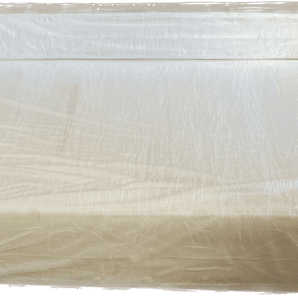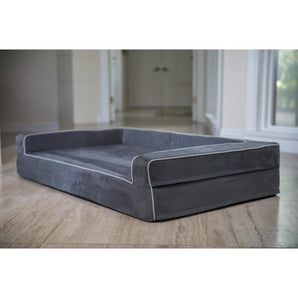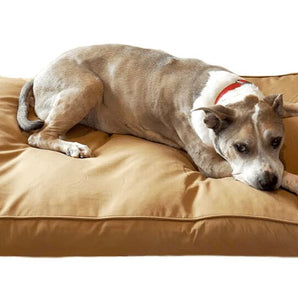When you break a nail, it's usually just a minor inconvenience. You file it down and move on with your day. But when your dog breaks a nail, it may be a bigger deal. Dog’s nails are quite different from human nails, both in structure and function.
Dog's nails have a hard outer shell made of keratin and an inner part called the quick, which contains blood vessels and nerves. This structure makes them strong yet sensitive, and they require careful trimming to avoid pain and bleeding.
If your dog's nail is broken, it’s important to know how to handle the situation to keep your furry friend comfortable and prevent further injury.
Is a Dog Broken Nail a Big Deal?

While it might seem like a minor issue, a broken or split nail can be quite painful for your dog. Although their nails are made of a hard outer shell, there's also a sensitive inner part called the nail bed, which contains blood vessels and nerves. In dogs, broken nails often expose the nail bed, which can cause significant pain and discomfort. An untreated nail injury can lead to infection, so it's important to take action if you notice any dog nail injuries.
What to Do If Your Dog's Nail is Broken

If you notice that your dog's nail is broken, it can usually be taken care of at home with a few simple steps. However, if the dog's nail is badly broken or split, you may need to contact your veterinarian.
For a simple nail break, follow the steps below.
Step 1: Assess the Damage
First, take a good look at the nail so you can see the extent of the damage. Is it just a minor chip, or is the nail completely torn? If the nail is split or hanging off, it might require more immediate attention. If the nail bed is exposed, it can be painful and prone to infection.
Step 2: Keep Your Dog Calm
Your dog is likely in pain and may be anxious or agitated. Calm your dog by speaking softly and gently petting them, or putting them in a comfortable and familiar place like their dog bed. Offering a treat can also help distract and soothe them. Keep your dog as still as possible to avoid further injury to the nail or the nail bed.
Step 3: Clean the Wound
If the nail is bleeding or if you see dirt around the injury, clean the wound gently. Use warm water and mild soap, or an antiseptic solution or an antifungal wipe. Avoid using anything too harsh that could irritate the exposed nail bed.
Step 4: Stop the Bleeding
Bleeding is common with nail injuries. Apply gentle pressure with a clean cloth or gauze to stop the bleeding. If the bleeding doesn’t stop after a few minutes, you can use a styptic powder or pencil, which you can find in most pet stores. Cornstarch or baking powder can also work in a pinch.
Step 5: Trim the Broken Nail
If part of the nail is still attached but is broken or split, you’ll need to trim it. Use dog nail clippers to carefully cut away the damaged part. Make sure to avoid cutting into the quick; the sensitive part of the nail that can bleed and cause pain. If you’re unsure, it’s better to wait and let your vet handle this step.
Step 6: Apply a Bandage
Once the nail is trimmed and the bleeding has stopped, you can apply a bandage to protect the injured nail. Use a non-stick pad and wrap it with a bandage or adhesive tape. Make sure it’s snug but not too tight, as you don’t want to cut off circulation to your dog's foot.
Step 7: Prevent Infection
To prevent infection, you can apply an antibiotic ointment to the nail bed before bandaging it. Keep an eye on the bandage and change it daily to keep the area clean. Preventing your dog from licking or chewing the injured nail is also important.
Monitoring for Signs of Infection
Even with proper care, there’s still a risk of infection. Watch for the following signs:
-
increased redness
-
swelling
-
a foul odor
-
pus coming from the nail bed
If you notice any of these symptoms, or if your dog seems to be in persistent pain, it’s time to visit the vet.
When to See a Vet

While minor nail injuries can often be managed at home, some situations require professional help. Seek veterinary care if:
-
The bleeding doesn’t stop after 20-30 minutes.
-
The nail is broken off near the base.
-
You notice signs of infection.
-
Your dog is in severe pain or is excessively licking the injured nail.
-
The nail injury occurs frequently.
Preventing Future Nail Injuries

Preventing nail injuries is easier than dealing with them. Regular nail maintenance is key:
-
Trim your dog’s nails regularly: Keeping your dog’s nails at a manageable length reduces the risk of breakage—short nails are much less likely to break. Use proper dog nail clippers and be cautious not to cut into the quick.
-
Smooth rough edges: After trimming, use a nail file to smooth out any rough edges that could catch on surfaces.
-
Check for nail health: Regularly inspect your dog’s nails and paws for any signs of damage or infection.
-
Provide a safe environment: Minimize your dog’s exposure to rough or sharp surfaces where they could catch and break a nail.
Caring for Your Dog’s Paws

Healthy paws are essential for your dog’s overall well-being. In addition to regular nail care, here are some tips for keeping your dog’s paws in top condition:
-
Moisturize: Dry, cracked paw pads can be uncomfortable and more prone to injury. Use a dog-safe paw balm to keep them soft and healthy.
-
Check for foreign objects: Regularly check between your dog’s toes for any debris like pebbles, glass, or thorns that could cause injury.
-
Keep them clean: After walks, wipe your dog’s paws to remove any dirt, chemicals, or salt, especially in winter.
-
Paw protection: If you’re walking on rough terrain or in extreme weather, consider using dog boots to protect your dog’s paws.
FAQs About Dog's Nails
Are dog's nails different than human nails?
Yes, dog's nails are different than human nails. Dog's nails have a hard outer keratin shell and an inner part called the quick, which contains blood vessels and nerves, making them more sensitive and prone to pain and bleeding if cut too short.
What causes broken dog nails?
Dogs break nails for a number of reasons, such as rough play, getting the nail caught in something, or running on hard surfaces. Nails that are too long or brittle due to poor nutrition or underlying health issues are also more prone to breaking.
How do you know if your dog's nails are too long?
You can tell if your dog's nails are too long if you hear them clicking on hard surfaces when your dog walks or if the nails extend beyond the paw pad when your dog is standing. Overly long nails may cause your dog discomfort or difficulty walking and can lead to more frequent nail injuries.
How long does it take for a broken dog nail to grow back?
A dog's broken nail will typically grow back in a few weeks to a couple of months, depending on the severity of the break and the dog's overall health and nail growth rate.
Do dogs need pain medication for broken nails?
Dogs may need pain medication if they break a nail, especially if the quick is exposed or the nail is severely damaged. It’s best to consult your vet to determine the appropriate pain management for your dog’s specific situation.
Should you take your dog to the vet if they have a torn nail?
Pet parents should take their dog to the vet if they have a badly torn nail, particularly if the bleeding doesn’t stop, the nail is broken near the base, the nail bed is exposed, or there are signs of infection such as swelling, redness, or pus.
Final Thoughts

A dog broken nail can be a painful and stressful experience for your pup, but with the right care and attention, you can help them heal quickly and prevent future injuries. Regular nail maintenance and paw care go a long way in keeping your dog comfortable and injury-free. Remember, when in doubt, consult your veterinarian to provide the best care for your furry friend.





